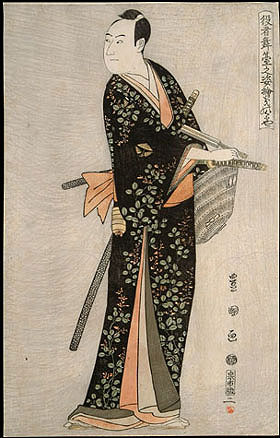TOYOKUNI
I
Last Master of the Grand Style
By Merlin C. Dailey
Utagawa Toyokuni I has long been an
enigmatic figure in the history of Ukiyo-e. He has been labeled
as an eclectic artist by both Japanese and Western critics
because he borrowed the style of others at random. Although
the last years of his career were spent in turning out coarse
and decadent caricatures of his former efforts, he was nonetheless,
a man of considerable talent who, for a short time, held together
a great but declining tradition. Between his earliest period
when he established a reputation as a versatile imitator and
his later years when his talent disintegrated to such a low
degree, Toyokuni I produced a body of work containing many
of the finest, most notable designs in the history of Ukiyo-e.
I would choose to see him as the last
great master of what could be called the Grand Style of courtesan
and actor print design. The Grand Style refers to that large
body of psychological portraits of Kabuki actors beginning
with the late Torii artists and continuing with Buncho, Shunsho,
Shunko, Shun'ei, Enkyo, Sharaku, Toyokuni I, and Kunimasa.
During this time, the actor portrait began to lose the idealistic
flavor of the Primitive period, characterized by such artists
as Masanobu and Toyonobu, and took on a new sense of dramatic
presence and realism. It became possible to identify certain
actors by their facial features, especially in the bust portraits
of Sharaku. The Grand Style developed in courtesan prints
with the tall, languid, semi-realistic figures fostered by
Kiyonaga and continued by Utamaro with his individualized
portraits of beautiful women. Choki, Eishi, Eisho, Eisui,
Shunman, Shucho, Shuncho and Toyokuni I maintained the Grand
Style with variations on the styles of these two masters up
to the beginning of the 19th century. With the noted exceptions
of Kiyonaga and Toyokuni I, who were gifted in depictions
of both actors and courtesans, most of these artists worked
primarily in either one or the other tradition.
|
 |

Born in Edo in 1769, Toyokuni was the
son of a woodcarver who made puppets and dolls. Growing up
in this environment, he was probably stimulated by the activity
of craftsmen and their tools. As a youth, he was apprenticed
to Toyoharu, founder of the Utagawa school, who was a great
exponent of uki-e (scenes in western perspective). Many of
Toyokuni's early triptychs of interior scenes of the Yoshiwara
reveal his sound understanding of this technique.

illustration 1
As an aspiring young artist, Toyokuni
found himself in a position similar to that of the mannerists
in Italy after Michelangelo. The great artistic and technical
innovations had either come to pass or were immanent.
(Click
here to continue)
|


